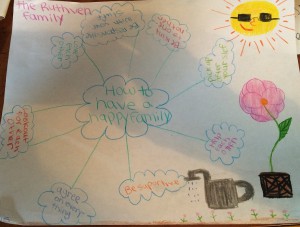
A Mirror into an “Organization”
I recently had a crazy idea to take my kids through a strategic planning process. It was sparked by one of those times when you feel misaligned as a family unit, and you’re acutely aware that your vision and desired experience has fallen out of step with daily realities.
I believed we each held a similar view of what we’d like our family to be like, and that what was lacking was everyone (obviously I mean them!) fully understanding their role and what is required to support each other and achieve our vision.
I summoned a sit-down with my “peeps” – Benjamin, 12; Jaxson 11; Olivia 10 – to layout my observation and suggested proposal. Through the conversation I let them know that facilitating discussions like this was part of what I do on a regular basis for clients as part of my career (which they’re still largely unclear about). Oddly, I felt the need to sell them on my expertise and ability. Tough crowd.
Quickly, their corporate personalities emerged and an aha moment happened for me – the exercise I had started with my kids perfectly paralleled actual team processes I had executed for various clients. In fact, because this is all so new to them and they’re pretty unencumbered as far as the corporate team game goes, it’s an amplified process; ripe with transferable learning moments and insights. I needed to document.
After my initial introduction, Olivia’s hand went up and she immediately dove into the details of what action items would help us achieve the family experience we wanted. Jaxson expressed concern of what happens if one of the others didn’t comply or do their part – how do we protect against failure? And Benjamin, sat quietly, thinking. When I pressed him to share he offered that he thought this was a good idea, but that he would wait to see what it looked like before he really could say for sure how he felt.
How many of you have these personalities on your teams (direct team, leadership or otherwise)? Being aware of the personalities you’ll be moving through this process with, allows you to appeal to and leverage their tendencies and/or mitigate the affect on others.
I know I need to provide Olivia with practical, detailed examples and scenarios as we discuss concepts and ideas. I will need to consciously move her forward to avoid her becoming stuck and focusing on details or thinking the detail means we’re done (& thereby avoiding the all important journey). Jaxson brings to the table the fairness and equity cards by requiring assurance that both his brother and sister understand that they will be equally required to participate and take equal ownership for any plans that come out of this process. Benjamin needs to understand the complete process, see the benefits and ensure logic is appropriately accounted for.
And most importantly, I need to realize that I need to experience the process and be open to hearing that I might not be fully aligned to their vision (could be I don’t engage in sports enough). Maybe our family vision looks slightly different than I thought. I saw myself falling into the leadership trap of viewing the problem & required work to be residing only at the “staff” level (don’t we all wish our kids could be staff – not the other way around!!). I know a shared vision doesn’t happen top-down, but here I was (although to be clear, I will take the role of a strong leader who sets the tone for culture and required outcomes, etc.).
We had successfully agreed that there’s a problem and room for improvement, and embraced the steps and roles/responsibilities we’re going to follow to get there together. Our mandate is set.
Next, we’ll take our first step forward by focusing on vision development and alignment. We had a brief discussion over the question that should be posed (& posted in a high traffic area alongside sticky notes and about a thousand pens) in order to facilitate the articulation of values. I’ve been testing out a few options and will talk about that next time.
Knowing your audience, their take on the process and what you need to keep in mind (and in play) during the work is a fundamental starting place. We’ve started our journey and we’ll see where this crazy idea takes us and what we learn – about ourselves and the art of the strategic planning process – along the way.
Within an hour of concluding our discussion, Olivia presented me with her “answer.”
Next time: The Question

Stunning example of what can happen when you treat children with love, respect, inclusiveness and ask them to contribute. I wish everyone would give this type of opportunity to their children to think, be creative, examine group dynamic and themselves. I think you should bottle it!